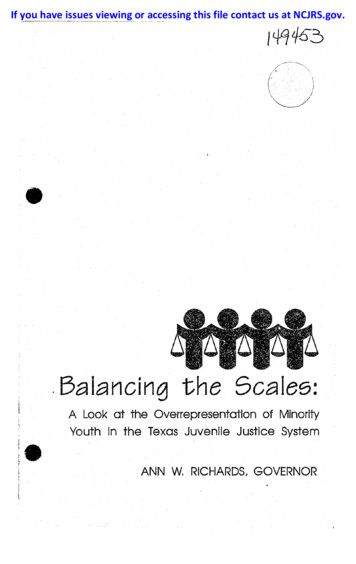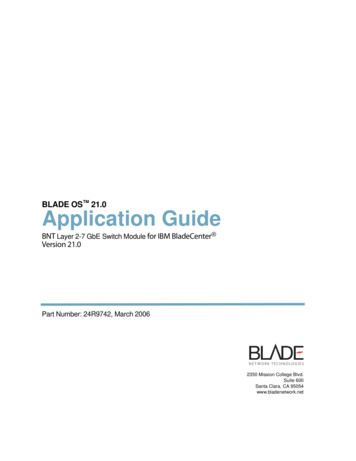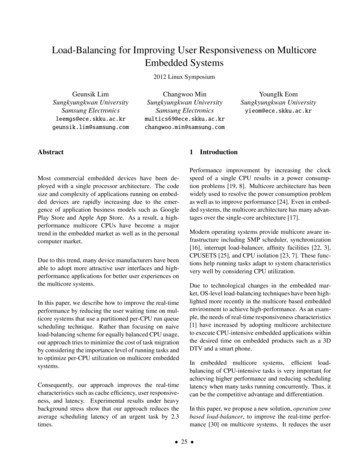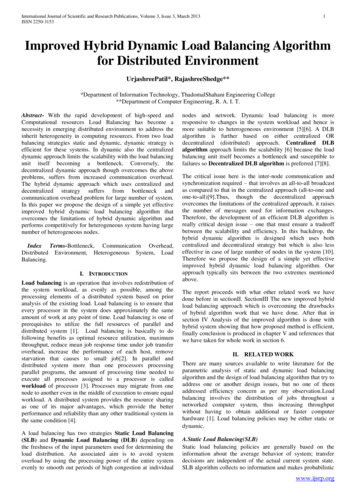
Transcription
If you have issues viewing or accessing this file contact us at NCJRS.gov. . Balancing the Scales:'.A Look at the Overrepresentation of MinorityYouth in the Texas Juvenile Justice SystemANN W. RICHARDS , GOVERNOR
Balancing the Scales:A Look at the Overrepresentation of Minority Youthin the Juvenile Justice System149453U.S. Department of JusticeNational Institute of JusticeThis document has been reproduced exactly as received from theperson or organization originating it. Points of view or opinions stated inthis document are those of the authors and do not necessarily representthe official position or policies of the National Institute of Justice.Permission to reproduce this copyrighted material has beengra as Office of the Governorto the National Criminal Justice Reference Service (NCJRS).Further reproduction outside of the NCJRS system requires permissionof the copyright owner.Office of the GovernorCriminal Justice DivisionTom Vickers, DirectorANN W. RICHARDS, GOVERNOR
Balancing the ScalesGovernor's Juvenile Justice &Delinquency Prevention Advisory BoardMr. Raul Garcia, ChairmanSan AngeloMs. Esther Alvarez,Fort WorthMs. Kathy HuttoAustinThe Honorable Santiago Barrera, Jr.,San DiegoDr. M. 1. JacksonHOllstonThe Honorable Robert BaumHoustonMs. Ethel JonesTexarkanaMlr. Raymond Bonney anMr. Timothy LimonAustinDr. Melvin Brown Jr.ConroeMr. Richard MarlerGrovesMr. Ron CastanedaAustinMr. Robert MendozaAustinMs. Olga ChavezAustinMs. Earlean MitchellSan AntonioThe Honorable Arnaldo CorpusMissionMr. Barrett Muhlenbri.tchLaredoMr. Calvin CrenshawGiddingsMr. Benito PerezCrystal CityMr. Stuart FeinblattAmarilloMs. Catherine RevettAmarilloThe Honorable Jesus GarzaLaredoMr. Roy RobbSan AngeloMr. Pete HarrellAustinThe Honorable Robin SageLongviewMr. Bobby HeardDallasMs. Lidia Se.rrataVictoriaMr. Thomas Henderson ustinMr. Robb SoutherlandAustinr . Christopher HoelterAustinMs. Theresa Andreas TodAustinMs. Belinda HollandBonhamMs. Jane WetzelDallas
Balancing the ScalesSubcommittee on Minority Youth in theJuvenile Justice SystemMr. Calvin Crenshaw, ChairmanGiddingsMs. Esther AlyarezFort WorthMs. Betty Duke KentHoustonMr. John ArredondoPhoenixMs. Laura KingAustinMs. Olivia BesteiroAustinDr. Bernard LicarioneAustinMr. Steve BonnellAustinThe Honorable Sue LykesDallasMr. Joe CastilloAustinThe Honorable William MartinLongviewDr. Pat ColeAustinMs. Teresa RamirezHoustonDr. Margaret DunnSan MarcosMr. Roy RobbSan AngeloMs. Adrian FowlerAustinMr. Robb SoutherlandAustinDr. Sylvia GarciaAustinMr. Bill ThompsonDallasMr. PatrickJ. GarzaSan AntonioMs. Theresa Andreas TodAustinMr. Charles A. GunterSan AntonioBishop William WatsonLubbockMr. Ron JacksonAustinMs. Jane WetzelDallasDr. Charles JeffordsAustinMr. Levi WilliamsDallasMs. Susan JohnsonAustinMr. Bob WoodsTylerMs. Ethel JonesTexarkanaMs. Vicki WrightAustin
:. . .:1Balancing the ScalesTable of ContentsBackground . ". 1Overview . ". 3Prevention . 7Diversion . 13Alternative Placements . 15Aftercare . ". 21Research and Data Collection . 23Training .27e oo e Appendix A-Documentation of Overrepresentation . 29Appendix B-Additional Information . 37Appendix C-Statewide and Demonstration Projects . 51Appendix D--Definitions . 69Appendix E-Bibliography . 71
Balancing the ScalesBackgroundThe Governorls Criminal Justice Division (CJD) administers thefederal Juvenile Justice and Delinquency Prevention Act OJDPA)in Texas. This Act requires that the states conduct research todiscover whether or not there is an overrepresentation of min.ority youth in their juveniles justice systems. The Act also requiresthat if overrepresentationexists, the states must address efforts toreduce the proportion of minority youth in the system.In the Fall of 1990, the Governor1s Juvenile Justice and Delinquency Prevention (JJDP) Advisory Board formed a Subcorrunittee on Minority Youth in the Juvenile Justice System to look at theproblem of overrepresentation. In 1991, Tom Vickers, the newdirector of CJD, invited experts in all areas of juvenile justice,youth services, and education. to become a part of the subcommittee that would design a plan to address this problem.Before the first meeting of the new subcommittee, the staff of CJDconducted the required research and documented that overrepresentation does exist. The staff also provided additional information regarding the types of juveniles who are in the system byracial and ethnic group.The subcommittee met throughout the summer and fall of 1991 todiscuss the problem and its possible causes. To facilitate the depthof attention required, the subcommittee divided into groups toaddress the individual areas of prevention, diversion, alternatives, aftercare, data collection, and training. During these meet··ings, the subcommittee made recommendations aimed at improving the system and developing model programs. This document is a compilation of those recommendations and the stepstaken by CJD to implement them.Page 1
-------------------l1liBalancing the ScalesOverviewInitial research into the question of overrepresentation ohninority youth in the Texas juvenile justice system showed that there isindeed a problem. Fifty-nine percent of all youths arrested in 1989were of a minority group. This overrepresentation goes on into thesystem with seventy-three percent of all youths detained and seventy-four percent of all youths committed to the Texas YouthCommission being parts of minority groups.The extent of overrepresentation differs between the two largestminority groups. Hispanic youths are only slightly overreprE sentedin Texas, while the percentage of Blacks is much higher. Whiteyouths are generally underrepresented.In exploring studies of troubled youths, several characteristicscontinued to reappear. Among prison inmates, a childhood ofpoverty, family violence and abuse, dropping out of school, substance abuse, and an inability to find or keep a job are commonproblems. Handicaps and learning disabilities also are indicators ofpotential trouble in young people. While it is impossible to isolatethe causes of overrepresentation with the available information,several significant factors were found. Among these are the numberof prior referrals, family living arrangements, and school status.Black youths had the greatest number of referrals with anaverage of 4.3 during 1989. Hispanic youths were close with anaverage of 4 referrals during the year. Whites had fewer referralswith an average of 2.8. Further research is needed to determinewhether minority youths had more referrals because they committed more offenses or whether other factors, including selection bias,played a part.The most common living arrangement for all juveniles who comeinto contact with the system is with a single mother. Half of Blackyouths at the point of referral live with their mother only. This trendis also true for Hispanic and White youths, who live with a singlemother approximately thirty percent of the time.The probation statistics compiled specifically for this report wereinsufficient to show a strong link between school status and crimeinvolvement. According to these figures about seventy-five percentof all youths referred to juvenile court were enrolled in school,working on a G.E.D. or had graduated. However, these figures donot show how regularly the youths were attending school. But otherPage 3
Balancing the Scalesfigures indicate a link between school attendance and serious orrepeated criminal activity since approximately half of all youthscommitted to the Texas Youth Commission (TYC) in 1989 were notattending school on a regular basis. In addition, the average educational achievement of Texas prison inmates is seventh grade.Each of these indicators suggests certain remedies. First, it isimportant to begin prevention efforts with the very young. Theseefforts must begin with aggressive outreach to ensure that properprenatal care and training is given to expectant mothers so that theymay raise healthy, well-adjusted children.Second, strong emphasis must be given to early childhoodeducation. Pre-school education programs must be expanded sincemany children face huge gaps in learning readiness when they startschool. Children who are helped and encouraged to learn may startschool with working vocabularies that are up to ten times greaterthan those of the other children. Many of these other children live insingle parent homes, usually with single mothers who often do nothave the time or the educational background to help their childrenlearn. A great number of these unmarried mothers are teenagers,and since at least twenty percent of all sixteen to nineteen year oldwomen with below average academic skills become mothers whilethey are still teenagers, man y children are entering school with greatdisadvantages. Most of these children will continue to be behind forthe rest of the time they spend in school. It is not surprising thatschool is not a rewarding experience for them, so they look for otherways to succeed and may drop out as soon as they can.In addition to addressing the roots of children's problems,emphasis must be placed on making the juvenile justice system asunbiased as possible. Standard criteria should be developed for thearrest, detention, placement, and commitment of juveniles. Forthose parts of the system that already have standard criteria, thecriteria should be studied to ensure that they are culturally, racially,and economically unbiased.A step to lower the overrepresentation of minority youths in thesystem is to increase placement funds for alternatives. A mostdisturbing finding is that courts in Texas generally increase commitments to state secure facilities at midyear when local funds begin to run out. This trend seems to imply that many juveniles are notcommitted to state custody because of their offenses but because ofthe courts' budgets. These increased commitments tend to be mostlyminority youths. A contributing factor to this disproportion may bePage 4
Balancing the Scalesthat in Texas, thirty-one percent of all Black families and twentyseven percent of Hispanic families have incomes under the povertylevel and therefore do not have the money or insurance to securealternative placement for their children in private facilities.People who work with children must learn about the multicultural society in which we live and to be aware of cultural differences.Multicultural training that is centered on understanding the role ofcultural environments in people's lives and the impact of those rolesis crucial for juvenile justice, social service, and law enforcementpersonnel.In gathering the statistics for this report, it was found that thereare gaps in reporting in the area of juvenile justice. Many of thesamples used for this report are not statewide and the nature of thesystem would not allow random sampling. Work is in progress atthis time toward a standard statewide data collection system thatwill provide information on minority issues and others.IMPORTANT NOTE:In order to demonstrate the model projectsrecommended in this report, CJD has earmarked one-third of its federal Juvenile Justice and Delinquency Prevention (JJDP) Actfunds for unique and exemplary projects.Grants will be awarded through a Requestfor Applications process. See Appendix Cfor program descriptions and details . Page 5
3Balancing the ScalesPrevention The following recommendation &.is acfdressed to: . Community LeadersParentsTeachersSchool AdministratorsService ProvidersJuvenile Probation Personnel To prevent children from becoming involved in gang and drug , adultresidents must work together to take control of their communities.In studying juvenile crime and ways to prevent it, certaincharacteristics continue to reappear. These include family income,school status, and family living arrangements.In the state of Texas, thirty-one percent of Blacks and twentyseven percent of Hispanics live in poverty. The children of thesepoor families are about three times more likely to leave school thantheir wealthier peers. School status is linked to serious crime sincefifty percent of all youths entering the Texas Youth Commission arenot attending school on a regular basis anti the average educationalachievement of Texas prison inmates is seventh grade.The living arrangement of a child is also a predictor of criminalinvolvement. Of all youths entering the Texas Youth Commission,about fifty percent live with their mother alone. This rate is evenhigher for Black children.To improve such conditions, change must begin in each community. Coordination of efforts is important, since by working together, se.rvice agencies and community residents can form a network that will benefit more children than before.Through coordination, agencies and organizations can avoidduplication of efforts and can focus on the real needs of the community. Volunteers from within the community can be used to act asliaisons between the coordinated agencies and the residents. Theseliaisons have the advantage of being able to approach residentswithout the usual intimidating formality associated with socialservice agencies. By working together, the community could providea variety of services including parenting education, early childhoodprograms, educational enhancement programs, and many others.Page 7
Balancing the ScalesParentingParenting begins before a baby is born, through proper prenatalcare. Fifty-seven percent of pregnant teens do not receive anyprenatal care during the first trimester and malllY receive none at all.Through the use of community liaisons, pregnant women can belocated to make sure that they are receiving necessary health care.Once prepared physically to have a healthy baby, it is crucial fora pregnant woman to focus on preparing herself mentally to handlethe changes and responsibilities that lie ahead. A program thatbrings future mothers together to learn necessary skills and discusstheir feelings and questions is an important first step in raisinghealthy and happy children. Such programs can be run by the . .community using new mothers who have finished the program to . .help those who are just beginning.Since children go through a variety of phases as they grow up,it is necessary to have classes for parents that are specific to theirchildren's ages. Classes also can target the type of parent, whetherthey are single mothers or fathers, custodial grandparents or relatives, or other situations. Besides basic coping skills necessary toraise healthy children, other workshops are helpful to parents andfamilies. These workshops might include checkbook balancing,money management, and basic classes familiarizing families withavailable services and the means necessary to secure them .IIAs a Black person, when I see an image of someonewho looks like me, it's usually a negative imagesomeone selling drugs, stealing, killing or going tojail. The only positive image I see of someone wholooks like me is ofsomeone singing, dancing, playingbasketball, or some other sport. That is the image ofmyself that is projected to me by society. Wehavetochange that, we have to show Black children positive images of themselves, images of what they canbecome. And that is an ongoing process, not justsomething that is done once a year during BlackHistonJ Month."Levi WilliamsWilliams, Phillips, and AssociatesPage 8.rr. . . . . . . . . . . . . . . . . . . . . . . .a . . . . . . . . . . -.
Balancing the ScalesEarly Childhood ProgramsThe purpose of any early childhood program should be to fosterthe development of responsible, productive, and self-sufficient citizens. Its target should be the education of children, not simply daycare. Headstart is an example of a comprehensive service programthat gives pre-school children the tools they need to succeed inschool, especially in learning readiness and socialization skills. If aprogram such as Headstart does not already exist in a community,one should be started using whatever means are available. Inaddition to state and federal support, sources of possible fundinginclude support from private for-profit companies or private citizens.These programs should teach children to deal with anger, frustration, and aggression in non-violent and constructive ways. Theyalso should teach children a positive self-image and image of theirculture and others. In order to effectively portray a variety ofcultures, it is important that the staffbe culturally representative andtrained to understand various cultures. Both mothers lind fathersshould be encouraged to become involved and remain involved inthis and any other program in which they enroll their child.Academic Programs To maximize the potential of every child in the Texas publicschool system, the work must begin in individual schools. Ifchildren have the desire or the potential to attend college they shouldbe able to do so. By teaching children about college admissionstandards and scholarship qualifications and helping them to deviseplans to achieve these goals, children learn of the real possibilities.But many children have no aspiration to go to college. Thesechildren should be familiarized with the job market and the varioustypes of training that are available to them when they complete highschool. ldbe taught how to apply for jobs, how to compile a resume, and howto interview successfully.While children are in school it is imperative to ensure that theclassroom environment is conducive to learning. Alternative education programs keep children in school although they are no longerPage 9
Balancing the Scalesin regular classrooms. While these programs are very valuable intrying to keep classrooms as free of disruptions as possible theyshould only be used as a means oflastresort. The difficult transitionsthat alternative education students may experience when they moveback into regular classrooms can be upsetting not only to the studentbut to the other students in the regular classroom as well.Alternative education classes or individualized programs shouldbe offered during evenings and weekends. In this way, teenageparents and others who may have to work during the day are notforced to drop out of school altogether . On the other side, acceleratedprograms should be available for those students who are ahead intheir classes and can handle such a program."People support what they help to create. Parents,teachers, and students must hold a stake in theseprograms if they are going to work."Dr. Sylvia Garcia, DirectorSpecial Programs PlanningTexas Education AgencyAddressing the ProblemAny attempt to address problems in the juvenile and adultjustice systems must begin with efforts to improve the conditions inwhich the state's children live. To address these problems, Texashas made eligible in its 1993 Criminal Justice Plan grants for community-based prevention projects. These projects will use communityresidents as liaisons between the community and social serviceproviders. Intensive efforts will be made to identify hard-to-reachfamilies, especially chemically dependent parents, who are notreached by conventional means. Outreach workers will also beadvocates for their communities, organizing residents to work togethe:r to reduce crime. The goal is to get the additional services that areneeded if the community is to successfully counteract gangs and drugs.Page 10
!!I'Balancing the Scales&. The follo?,ing recommendation .&.lS acfdressed to: . I The Texas LegislatureThe Texas Public School SystemChildren must learn to have a positive image of their own andother cultures.It is believed that children often behave in ways that are selfdestructive because they have not learned to respect themselves andtheir own cultures. Also, these children may behave in ways tha taredestructive to others because they have pot been taught to respectother people and their cultures. To help children develop thesequalities, the following steps should be taken at the state level: Mandate that all public schools infuse multiculturally sensitivematerial throughout the existing curricula. Increase teacher in-service days to provide additional training instaff development. During these training days, educate teacherson proper disciplinary procedures and teach skills for dealingwith at-risk youth. Include a multicultural component to helpteachers better deal with the variety of children in their classes. Page 11
Balancing the ScalesWhat you can do in your community: Set up a telephone hotline to link callers with appropriateservice providers via 3-way calling. Develop a resource directory for your community. In it listall of the agencies and available programs with addresses,phone numbers, contact persons, and a brief synopsis ofservices provided. Use public service announcements toshowca';e certain agencies and services within the directory. Set up a Scholarship Clearinghouse to ensure that allcollege-bound students apply for the scholarships they areeligible for and that all scholarships are awarded. Also,provide financial aid information about trade schools andvocational training programs. Look into the programs available through both the stateand federal governments. An example is the ResidentInitiative Program of the Department of Housing andUrban Development. These programs, within housingprojects, include support groups, family literacy training,and others. All state and federal requests for applicationsare published in the Texas Register and Federal Registerrespectively. Urge local advertisers and media to be culturally sensitiveand show the positive sides of all types of people. Invite successful individuals from all racial and ethnicbackgrounds to speak to classrooms and assemblies sothat children may see positive role models they can identify with. Support or begin local programs that effectively provideservices such as clothing, shelter, and medical care tochildren in need. In many places these services are onlyreadily available through contact with the juvenile justicesystem.Page 12
Balancing the ScalesDiversion.&. The following recommendation .&.is acfdressed to:QI QIQLocal Juvenile Probation DeparbnentsEvery child who is referred to juvenile court but is not adjudicatedshould go through a diversion or first-offender program.Often children who are arrested and referred to juvenile court arecounseled and released. Some children are placed into first-offenderprograms aimed at preventing further contact with the juvenilejustice system. Unfortunately, many juveniles do not have thebenefit of such a program. Under Section 52.03 of the Texas FamilyCade, an intake officer is authorized to attach reasonable conditionsto F leasing a youth. It would be beneficial if all children who arereferred to juvenile court went through this type of program as acondition of release.Diversion programs should stress accountability for one's actions and restitution should be required. Programs should containoffense-specific education so that the youth understands that thejuvenile justice system is not a joke and that further contacts with thelaw will ;result in increasingly serious action. Programs also shouldbe community-based so that parents can be involved and the youthcan see the community's reaction to his actions.To best help the child, individualized intervention should occur.This means that substance abuse services, job training, and othercounseling are provided when appropriate. The program shouldalso offer a CO;:;ltinuum of services based upon the needs of the child,not the financial means of the family.Page 13
Balancing the ScalesAlternative Placements The following recommendation is acfdressed to:The Texas Legislature The state legislature should increase funds for alternative placements so that juvenile court budgets do not dictate commitmentsof juveniles to state custody.Whites in the juvenile justice system are overrepresented inprivate facilities while Blacks and Hispanics are overrepresented inpublic facilities. One of the reasons for this overrepresentation is thatWhite families typically have access to greater resources such asinsurance. Rather than spend already scarce funds to place a childin a publicfacility, a judge may allow a child to be placed in a privatefacility paid for by the parents. Under the principle of equalprotection of the law, access to services should be based on the needsofthe child, regardless of family financial means or priva te insurancecoverage. "There's not a year that goes by thatprobation chiefsand juvenile court judges aren't forced to maketough decisions on who gets the limited government-sponsored alternativeplacement beds and whoremains locked up. Unfortunately, it's often theminority juvenile who remains locked up because ofa lack of resources."Robert WoodsChief Juvenile Probation OfficerSmith CountyPage 15
Balancing the Scales !.&. The following recommendation .&is acfdressed to: I i' I rrThe Texas LegislaturePolice and Sheriff's DepartmentsJuvenile Probation DepartmentsJuvenile ProsecutorsJuvenile Judges1 ;1It! ,! Standard, culturally unbiased criteria should be used by all juve-!inile justice personnel to make decisions regarding juveniles,including alternative placements. 1Arrest is the most critical point of the juvenile justice system. Lawt enforcement officers have wide discretion when processing a youth.Choices range from a sirnple warning to taking the child into custodyr and referral to court. Researchers have looked into the rate of youth! police contacts and the conclusion is that most law enforcementofficers make decisions without clear guidance and uniformity.The same is true for detention intake personnel. In Texas, theFamily Code requires release of a juvenile unless he meets at leastone of six criteria. In order for a youth to be detained, he must:iIt be a fugitive; have committed a felony and may be dangerous to himself or others; be likely to abscond; have no parent or guardian able to return him to court;, have no suitable supervision; orIl have been previously adjudicated.According to the National Council on Crime and Delinquency, if, the reasons stated above were followed objectively, no more than tenpercent of all arrested youths would be detained. In Texas, thirtypercent of all referrals were detained in 1990.Ii IPage 16
Balancing the ScalesOnce a youth has been referred to juvenile court, a decision mustbe made whether or not to file a petition. This decision is made byan officer ofthe court or a prosecutor. Once again, these officials havewide discretion, and there are few guidelines for the use of thatdiscretion. This lack of uniformity in decision-making is documented by the fact that nationally, petitions are filed in fifty-threepercent of the cases involving non-whites and only thirty-six percentof the cases involving whites. Thjs trend is true for all types ofoffenses.r.1'ilf minorities are living in communities with highcrime and are thus overly represented in the juvenilejustice system, the reason may be as much a societalreaction of the justice system decision-make'rs asthe result of socialization processes for the youth.""Minority Youth in the Juvenile Justice System:A Judicial Response"National Council of Juvenile and Family Court JudgesIn ''Minority Youth in the Juvenile Justice System: A JudicialResponse", the National Council of Juvenile and Family CourtJudges recommended that criteria and guidelines be designed foruse by all juvenile justice personnel. In keeping with this recommendation, the Texas Legislature should provide for the development ofstandard, unbiased decision-making criteria to be used by juvenilejustice personnel and law enforcement officers. This task wouldinclude arrest criteria, detention intake criteria, court petition criteria, and pre-placement assessment instruments for juveniles beingplaced in residential facilities. Research into the common assessment instruments currently being used for residential placementshould be done to ensure that they are culturally and raciallyunbiased. Once adopted, the legislature should mandate the use ofthe instruments throughout the juvenile justice system. Moremformation about the development of this criteria is found in thechapter on Research and Data Collection.Page 17
Balancing the Scales&. The following recommendation .&. I is acfdressed to: . The United States CongressThe Texas LegislatureHuman Service AgenciesChildren should not have to come into contact with the juvenilejustice system to receive primary care or treatment.The juvenile justice system provides a variety of services andtreatment to young people. Unfortunately, many children do nothave easy access to such services outside of the system. Conventional social service agencies often are not able to reach the peoplewho really need services such as dysfunctional families with drug,alcohol, and abuse problems. These families either do not knowhow to secure services for themselves orrefuse to accept help for anynumber of reasons. Therefore, many youngsters only receive services such as psychological assessments, counseling, substanceabuse prevention training, and in many
Ms. Earlean Mitchell San Antonio Mr. Barrett Muhlenbri.tch Laredo Mr. Benito Perez Crystal City Ms. Catherine Revett Amarillo Mr. Roy Robb San Angelo The Honorable Robin Sage Longview Ms. Lidia Se.rrata Victoria Mr. Robb Southerland Austin Ms. Theresa Andreas Tod Austin Ms. Jane Wetzel Dallas











